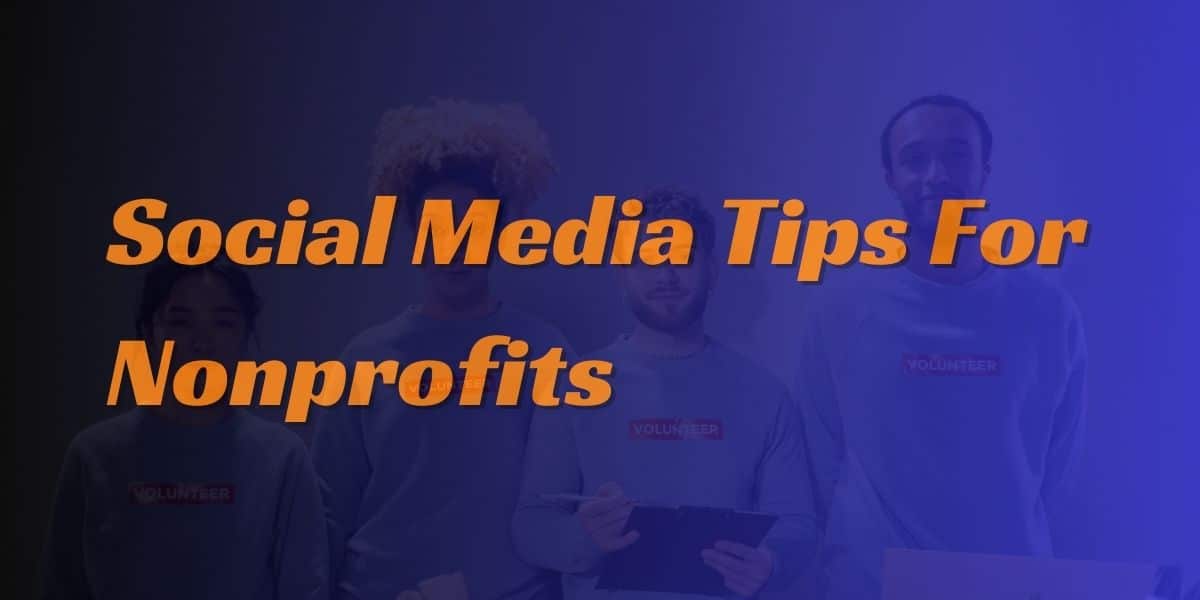Nonprofits are organizations driven by a mission to serve the public good, operating without the aim of distributing profits to members or owners.
Implementing effective social media tips for nonprofits is crucial in leveraging the full potential of these platforms, allowing organizations to amplify their impact and reach a broader audience.
The power of social media for nonprofits cannot be overstated. It is a potent tool for fostering connections with audiences, raising awareness about causes, and garnering support and donations.
Purpose of Social Media Tips for Nonprofits Guide
This comprehensive guide is designed to equip nonprofits with the essential knowledge to develop and execute a successful social media strategy for nonprofits. It encompasses crucial aspects such as identifying target audiences, setting clear objectives, creating engaging content, nurturing relationships, and assessing performance.
How do I Promote my Nonprofit Organization?
Promoting your nonprofit organization requires a strategic approach that leverages various channels and techniques to raise awareness, engage supporters, and attract potential donors. Here are some effective strategies to consider:
1. Identifying the Target Audience and Platforms
The initial step in formulating a social media strategy for nonprofits involves pinpointing the target audience. Understanding the demographics and preferences of the intended audience enables the selection of the most suitable social media platforms. Among the best social media for nonprofits are Facebook, Twitter, Instagram, LinkedIn, YouTube, and TikTok.
2. Establishing Clear Goals and Objectives
After identifying the target audience and the appropriate platforms, it becomes imperative to establish precise objectives for the social media strategy. Determining the desired outcomes, whether it’s increasing brand recognition, driving website traffic, or generating donations, lays the groundwork for creating specific and measurable goals. Tracking metrics such as follower growth and post reach helps in gauging progress.

3. Understanding the Organization’s Brand Voice and Message
Maintaining consistency between the organization’s brand voice and social media content is crucial. Defining the appropriate tone and style for communication, aligned with the core values of the organization, ensures a coherent and authentic representation across all social media interactions.
4. Content for Engaging Social Media Strategies for Nonprofits
Developing a content calendar assists in organizing and scheduling social media post Ideas in advance. This approach ensures a regular and consistent flow of content covering various topics, including organizational news, educational content, impactful stories, compelling visuals, multimedia elements, and effective calls to action.
5. Incorporating Storytelling and Impact-Driven Narratives
Storytelling is a powerful tool for nonprofits, enabling them to establish an emotional connection with their audience and motivate them to take action. By highlighting the stories of the individuals they serve and showcasing the impact of their work, nonprofits can evoke empathy and drive engagement.
6. Leveraging User-Generated Content and Testimonials
Encouraging the creation and sharing of user-generated content by followers fosters a sense of community and involvement. Additionally, leveraging testimonials from donors, volunteers, and beneficiaries helps build trust and credibility, providing tangible evidence of the organization’s impact.
7. Engaging the Community
Social media is a dynamic platform for fostering conversations and interactions. Actively responding to comments and inquiries from followers, as well as initiating discussions and soliciting feedback, contributes to building a vibrant and engaged online community.
8. Hosting Q&A Sessions and Live Events
Hosting live events and Q&A sessions presents a unique opportunity for nonprofits to interact with their audience in real time. These events can be utilized to address queries, provide updates, and strengthen connections with followers, fostering a sense of inclusivity and involvement.
9. Recognizing and Appreciating Donors and Volunteers
Publicly acknowledging and appreciating the contributions of donors and volunteers is essential for nurturing a culture of gratitude and support within the community. Sharing their stories through social media posts, expressing gratitude in public messages, and featuring them in visual content help in demonstrating appreciation and fostering continued engagement.
10. Optimizing Content for Engagement and Reach
Visuals and multimedia content play a significant role in capturing audience attention and driving engagement. Integrating high-quality images, videos, and infographics that are relevant to the content and the target audience enhances the overall appeal and shareability of social media posts.
11. Implementing Effective Hashtags and Keywords
The strategic use of hashtags and keywords amplifies the discoverability of social media content. By incorporating relevant and trending hashtags and keywords in posts, nonprofits can enhance their visibility and reach on various social media platforms, enabling broader audience engagement.
Regularly monitoring and analyzing social media analytics provide valuable insights into the performance of the content strategy. By tracking metrics such as reach, engagement, and click-through rates, nonprofits can identify successful content types and audience preferences, thus facilitating data-driven improvements and optimizations for future content creation.
12. Connecting with Other Nonprofits and Organizations
Collaborating with like-minded nonprofits and organizations presents opportunities for expanding reach and impact. Jointly promoting each other’s content, co-hosting events, and partnering on fundraising campaigns help in reaching a broader audience and creating a more significant collective impact.
13. Engaging with Influencers and Ambassadors
Engaging with social media for nonprofit influencers and brand ambassadors who align with the organization’s mission can significantly boost visibility and credibility. Leveraging the reach and influence of these individuals can help amplify the organization’s message and foster a deeper connection with a broader audience.
14. Integrating Donation Features and Calls-to-Action
Social media platforms often provide integrated donation features that simplify the process for supporters to contribute directly. Nonprofits can leverage these features to promote fundraising campaigns and facilitate seamless and secure online donations. Including clear and compelling calls to action in social media posts motivates followers to contribute to the cause.

15. Launching Fundraising Campaigns and Events
Social media is an excellent platform for launching and promoting fundraising campaigns and events. By providing regular updates, sharing compelling stories, and encouraging active participation, nonprofits can generate enthusiasm and support for their fundraising initiatives.
16. Highlighting Impact and Transparency in Fundraising Efforts
Transparency is key in building trust and credibility with donors and supporters. Nonprofits should emphasize the impact of their fundraising efforts, highlighting how donations contribute to the organization’s mission and the communities they serve. Providing regular updates and transparent financial reporting fosters a sense of accountability and confidence among supporters.
Understanding Policy Social Media for Nonprofit Tips
Adhering to legal regulations and privacy policies is paramount for nonprofits operating on social media. Understanding the legal considerations and privacy policies applicable to social media usage helps ensure compliance and ethical conduct in all online activities.
1. Implementing Transparency in Reporting and Data Usage
Maintaining transparency in the handling of data collected from social media interactions is critical. Nonprofits should communicate their data usage policies, ensuring user data is handled responsibly and following established privacy guidelines and organizational values.
2. Guidelines for Responsible Social Media Usage
Developing clear guidelines for responsible social media usage within the organization fosters a culture of integrity and professionalism. These guidelines should encompass the appropriate tone and language for communication, the types of content to avoid, and the protocols for addressing sensitive issues or inquiries. Establishing these guidelines ensures the organization’s social media presence aligns with its values and goals, maintaining a positive and respectful online reputation.
3. Identifying Key Performance Indicators (KPIs)
Measuring a social media strategy’s effectiveness requires identifying key performance indicators (KPIs) relevant to the organization’s goals and objectives. These KPIs may include metrics such as reach, engagement rates, click-through rates, conversion rates, and other specific indicators tailored to the nonprofit’s mission and initiatives.
4. Evaluating the Effectiveness of the Social Media Strategy for Nonprofits
Regular evaluation and assessment of the social media strategy are crucial to determine its overall effectiveness. By comparing the actual results with the predefined goals and objectives, nonprofits can gauge whether the strategy is yielding the intended outcomes.
Continuous evaluation enables organizations to identify strengths and weaknesses, allowing for strategic adjustments and improvements. Questions for evaluating the social media strategy may include:
- Is the organization effectively reaching the intended target audience?
- Are the content and messaging generating meaningful engagement with the audience?
- Is the organization successfully driving traffic to its website or donation platforms?
- Are the social media efforts contributing to the generation of leads and donations?
- Is the organization fostering genuine and lasting relationships with its audience through social media interactions?
Adjusting Strategies Based on Performance Metrics and Feedback
Flexibility is key when it comes to nonprofit social media strategy. Nonprofits should be open to refining their approach based on performance metrics and feedback from their audience.
Experimenting with different content formats, posting schedules, and engagement tactics helps in identifying the most effective strategies for audience engagement and conversion. Some helpful tips for adjusting non-profit social media strategy include:
- Experimenting with different content formats and analyzing their performance.
- Testing the effectiveness of various social media platforms to determine where the audience is most active and responsive.
- Paying close attention to social media analytics to identify high-performing content and engagement trends.
- Actively seeking feedback and suggestions from the audience to understand their preferences and expectations better.
Conclusion
With the help of a digital marketing agency for nonprofits, organizations have a rare opportunity to use social media to further their mission and influence in a world where platforms and trends are always changing. charities can effectively manage the complexities of social media, establish meaningful connections with their audience, and encourage action and support for their cause by utilizing the insights and methods provided in this guide together with the social media tips for nonprofit organizations.
AdditionalSocial Media Tips for Nonprofit
Authenticity and Genuine Engagement: Authenticity is the cornerstone of effective social media engagement. Nonprofits should strive to maintain a genuine and authentic online presence that resonates with their audience, fostering trust and credibility.
1. Consistency and Social Media Post Ideas
Regular and consistent posting on social media platforms helps in keeping the audience engaged and informed. Nonprofits should establish a consistent posting schedule that aligns with their audience’s preferences and behaviors.
2. Visual Allure
Visual content such as images, videos, and infographics are highly effective in capturing and retaining audience attention. Nonprofits should prioritize the creation and sharing of visually appealing content that complements their messaging and resonates with their target audience.
3. Responsiveness
Timely and thoughtful responses to audience comments, inquiries, and messages demonstrate the organization’s commitment to fostering genuine relationships and community engagement. Nonprofits should prioritize active and meaningful interaction with their audience to cultivate a vibrant and supportive online community.
4. Gratitude and Appreciation
Acknowledging and appreciating the support of donors, volunteers, and supporters is essential for nurturing a culture of gratitude and fostering lasting relationships. Nonprofits should express gratitude and appreciation openly and consistently, recognizing the vital role played by their supporters in advancing the organization’s mission.
By integrating these additional social media tips and tricks into their nonprofit strategy, nonprofits can maximize their online presence, build meaningful connections, and drive positive impact and change within their communities and beyond.
